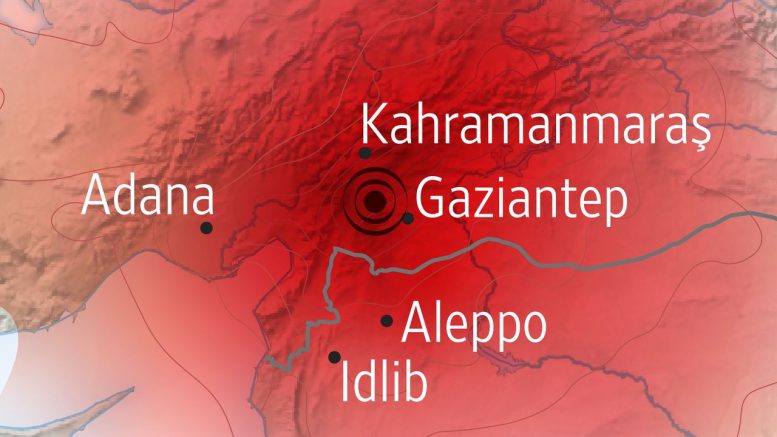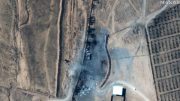On February 6th, two major earthquakes struck Syria and Türkiye. Since then, the countries have been hit by more than 600 aftershocks. As of February 13th, the quakes have killed more than 40,000 people, and wounded countless others. They struck an area home to an estimated 13.5 million people, many of whose homes have been destroyed. A huge number of buildings have collapsed. Türkiye has declared a three-month-long state of emergency, and both countries have received humanitarian aid, though it has been especially difficult for help to reach Syria.
The WHO has called the situation a “crisis on top of multiple crises.” In addition to the challenges of getting aid into the country, Syria has been fighting a civil war for nearly 12 years. The opposition-held area affected by the earthquake suffered an outbreak of cholera following the COVID-19 pandemic, straining the region’s wartorn healthcare infrastructure. Additionally, many people in the area live under impoverished conditions in makeshift structures that are unable to protect them from the region’s cold temperatures.
The Region’s Strongest Earthquakes in 20+ Years
The February 6th earthquakes were the strongest the region has seen since 1999. Striking at 4:17 am with an epicenter in Türkiye’s Kahramanmaras province, the first was designated a magnitude 7.8. The second, a magnitude 7.6, followed less than 12 hours later. A magnitude 7 earthquake is considered major.
The hundreds of aftershocks that followed have been magnitude 4 or below—comparably minor, but still felt by people in the region and able to cause some damage.
Humanitarian Response
While rescue missions and aid delivery are underway in both Syria and Türkiye, responses in devastated areas have been hindered by cold weather, poorly equipped and damaged hospitals, and a lack of machinery capable of digging through the rubble. In many cases, people have resorted to using their hands. Damage to roads has prevented people and aid from being transported to the area, and many of the region’s roughly 4 million internally displaced people are without food, shelter, and access to basic services.
Countries including the US, the United Arab Emirates, Canada, and Saudi Arabia and organizations like the UN and the Norwegian Refugee Council have provided aid items, in-person support, and funds to Syria and Türkiye, while others have assisted only Türkiye.
Difficulties Delivering Aid to Syria
Opposition-Held Territory
While international aid has been able to enter Türkiye with relatively little difficulty, Syria’s political situation has hampered the flow of aid into the country. Civil war has been ongoing in Syria since 2011, and much of the country’s northwestern region—the part most devasted by the quakes—is under the control of Hayat Tahrir al-Sham, a terrorist group opposed to the Assad regime.
For years, aid has entered Syria’s northwestern Idlib province from neighboring Türkiye. There is a single border crossing in the province, Bab al-Hawa, that the UN is authorized to use to access rebel-controlled territory. However, the crossing was damaged during the earthquakes, delaying the delivery of items like blankets and hygiene kits. Hayat Tahrir al-Sham’s presence in the region also “limits the kinds of aid many donors are prepared to supply to the area,” according to Middle East Institute non-resident fellow Emma Beals.
Routing aid through the Syrian government in Damascus was considered as an alternative to direct delivery but was foregone because of sanctions against the country. Russia, which supports Assad, has pushed for aid to be channeled through Damascus, but foreign governments have not been willing to negotiate their current terms with Assad.
US State Department spokesperson Ned Price told reporters that it would be “ironic, if not even counterproductive, for us to reach out to a government that has brutalized its people over the course of a dozen years now.” He said the US would continue to direct aid to Syrians in need through “humanitarian partners on the ground” rather than Damascus.
On February 9th, three days after the first quakes struck, a UN Office for the Coordination of Humanitarian Affairs convoy crossed Bab al-Hawa into Syria. According to CNN, the six trucks delivered shelter items and non-food item kits. The UN says that future deliveries will include medical supplies and food items.
More recently, however, UN aid chief Martin Griffiths acknowledged via tweet that the UN has “so far failed the people in northwest Syria. They feel rightfully abandoned. Looking for international help that hasn’t arrived.”
When aid arrived days after the quakes first struck the region, the twenty trucks carried “scheduled aid,” according to Raed al-Saleh, leader of the Syrian White Helmets volunteer organization. The aid included things like flour, sugar, and cooking oil, which are routinely delivered to Syria’s refugee camps. “It wasn’t aid for the families and people in the towns and cities which were in the disaster of the quake.” al-Saleh said.
The BBC reports that as of February 14th, 58 aid lorries had entered opposition-held Syria via Bab al-Hawa.
Though the possibility was initially rejected by Russia, the UN has announced that two additional border crossings, Bab al-Salameh and al-Rai, will be opening for three months.
Government-Held Territory
It has also been difficult for international aid to enter affected areas controlled by the Syrian government. As with the aid intended for opposition-held areas, the Russian and Syrian governments have pressured NGOs and governments to deliver aid to Damascus, to be redistributed by the Assad regime. Aid-providing entities, however, have denied the regime’s request.
A State Department spokesperson told AP, “Our partners in regime-controlled areas directly deliver assistance to beneficiaries without control or direction from the Assad regime. This is to ensure that our assistance is not diverted by malign actos or the Assad regime and reaches the intended beneficiaries.”
The Assad regime has a record of “serious violations of international humanitarian law,” according to Amnesty International. Over the course of the Syrian civil war, the government has “carried out direct attacks on civilians and civilian infrastructure…and indiscriminate attacks through arerial bombing and artillery shelling in Idlib governate and western Aleppo countryside.”
Activists like Omar Alshogre, Director for Detainee Affairs at the Syrian Emergency Task Force, agree that the “regime doesn’t qualify to put its hands on aid,” and say, “the sanctions imposed on the Syrian regime do not affect the enry of humanitarian aid to the Syrian people.” Rather, “the Syrian regime is trying to lift the sanctions so that it can finance the killing machine that has claimed the lives of a million Syrians, displaced half of the people, and is still torturing more than 100,000 detainees.”
AP also writes that “in theory, aid operations in government areas should not be blocked by sanctions, since both the US and the EU have exemptions for humanitarian aid.”
However, in both government- and opposition-held Syria, local emergency workers have reported a delay in aid delivery. “There are promises that aid will get to us but nothing has gotten here yet,” al-Saleh told AP on February 7th.
Aid to Türkiye
Since the Turkish parliament voted to declare a three-month state of emergency in the southern provinces that were hit by the quakes, countries and NGOs have begun to deliver aid to Türkiye.
The World Bank has announced that it will provide Türkiye with $1.78 billion in aid. $780 million of this will be offered immediately by the Contingent Emergency Response Components of two existing World Bank projects in the country.
The US State Department has also promised on-the-ground support and funds to both Türkiye and Syria. In a February 9th press statement, Secretary of State Antony Blinken announced $85 million in “urgent humanitarian assistance” to the countries and said that the United States Agency for International Development’s Disaster Assistance and Response Team was “already hard at work in southern Türkiye.”
Anger over Turkish Government’s Response
The Turkish government has been criticized for “what many see as its lack of preparation and sluggish response to the tragedy,” according to NPR. Erdogan himself has said that “the first day we had some discomforts,” though he argues that the “second day, and then today, the situation got under control.”
After a 1999 earthquake in northwestern Turkey killed more than 18,000 people, the Turkish government imposed an earthquake tax intended to be put toward disaster prevention and relief. However, critics like opposition leader Kemal Kilicdaroglu say the collected money is not really invested in earthquake management. “They grease their cronies’ palms with earthquake taxes,” Kilicdaroglu said. “Where is that money? It’s gone.”
Erdogan’s centralization of the Turkish government has also restricted cities’ and aid organizations’ operations, making it difficult for them to launch rescue efforts.
With Erdogan already weakened by Türkiye’s recent inflation, experts say the president’s response to the quakes has put him in an even worse position for the upcoming elections in June. “I would expect the government to actually be one of the victims under the rubble of this earthquake,” Soli Ozel, lecturer at Kadir Has University, told NPR.
Building Collapse in Turkey
As rescuers pull the last survivors out of the rubble, Turkish authorities have begun to address the collapse of buildings in the affected area. Many of these buildings were recently constructed apartments, which should have been able to withstand the earthquakes had they adhered to construction regulations.
“The maximum intensity for this earthquake was violent but not necessarily enough to bring well-constructed buildings down,” said Dr. David Alexander, a professor of risk and disaster reduction at University College London. “In most places, the level of shaking was less than the maximum, so we can conclude out of the thousands of buildings that collapsed, almost all of them don’t stand up to any reasonably expected earthquake construction code.”
The BBC writes that Turkish governments have provided builders “construction amnesties,” or legal exemptions from the building code, for a fee. According to the head of the Union of Chambers of Turkish Engineers and Architects’ Chamber of City Planners Pelin Pinar Giritlioğlu, up to 75,000 buildings in the affected area of Türkiye were given amnesties. The most recent were constructed in 2018.
Days before the earthquakes struck, Turkish news outlet Sabah reported that a draft law that would grant amnesty to 2023 constructions is pending parliament’s approval.
More recently, Turkish officials have said that they have issued 113 arrest warrants related to the construction of the buildings that crumbled during the quakes. They have taken at least 12 people into custody.
Rescue Missions “Coming to a Close”
UN aid chief Martin Griffiths has said that the rescue phase of response to the quakes is “coming to a close.” As the response moves forward, focus will shift to shelter, food, and education for those affected.
Though they are few, some people continue to be rescued from the rubble despite having been trapped for more than a week.
Meanwhile, the WHO has warned that a health crisis will follow the quakes. Many are without shelter as temperatures drop below zero. Some have no access to food, clean water, or hygiene products, increasing their risk of infectious disease. Wounds sustained during the buildings’ collapse also pose a threat. All of these issues will be made worse by the fact that much of the region’s healthcare infrastructure was destroyed.
According to Mervat Alhaffar, a research fellow at the London School of Hygiene and Tropical Medicine, some of the earthquake survivors will also develop psychological conditions like post-traumatic stress disorder. Alhaffar points out that many of those affected “will already have experienced multiple displacements in recent years, on top of losing friends, family members, and their homes.”






Be the first to comment on "Syria, Türkiye Hit by Strongest Earthquakes in 20+ Years"